I was 22 the first time I encountered a “sausage and peppers”, the street food sandwich ubiquitous in Italian celebrations in and around New York. I’d just moved there, and some new friends invited me to go to the San Gennaro festival with them. We didn’t have big Italian festivals in Ann Arbor, where I grew up, and the menu at the first restaurant I ever worked at, Falsetta’s Side Door, was not the most extensive one. Funny, I just had the thought – I’ve kept all my notebooks over the years from every restaurant I ever worked at. I wonder how I’d feel nearly fifty years on, about those recipes. We might just have a fun new blog series.
Here in Argentina, the incarnation of that sandwich shows up at street fairs in the form of chori a la pomarola, a local chorizo, usually lightly browned in a big disc pan (cover photo above), and then cooked along with added onions, peppers, and tomatoes. I don’t know if it’s because it’s considered street food, or kind of peasant food, or just that the ubiquitous choripan, a butterflied and grilled chorizo on bread dominates, but it’s rare… very rare… to see this on a restaurant menu. And, when you do, it’s almost never in sandwich form, but plated. I’ve set out to track down those few and far between places and sample different versions of the classic, and, it often seems, guilty pleasure, dish.
I guess there are going to be three things to look at in comparing the various versions of chori a la pomarola – the chorizo itself, the salsa pomarola, and the accompanying guarnición. My Virgo bent is to come up with some sort of rating, but I think I’ll just… not do that.
El Sanjuanino, Posadas 1515, Recoleta – One of my longtime favorite spots for casual Argentine food, it’s usually the first place I take visitors to who want to try “the real stuff”. No pretentions, no frills, just good food and service. I think I’ve had the same waiter every time I’ve been, which has to be, since I first went there in July 2005 on my empanada quest, probably 35-40 times.
The chorizo, unfortunately, is the least interesting part of this plate. It’s surprisingly bland. I don’t know whose chorizos they use, but there’s just no seasoning in the meat, certainly no salt, pepper, paprika… I really don’t know that I’ve had a blander chorizo. Had the rest of it not been so flavorful, I’d have started to worry about a covid relapse. But the salsa pomarola is superb – packed with onions, peppers, and tomato, all laced with a decent dose of garlic and maybe even a bit of chili, though it could be hot paprika. And the mashed potatoes are silky smooth, with a decent amount of butter, and well seasoned. I don’t know if they just got a batch of chorizos that the maker missed putting salt in, or if they’re always that way, but if they had a better, more flavorful chorizo, this would be a spectacular version of the dish.
Sion, Moreno 2402, Once – If there were ever a need for a poster-restaurant for the dictionary definition of “hole-in-the-wall”, this might just be the place to come. Half a dozen small tables, everything a bit rickety, an open kitchen that looks like it had seen better days long before better days arrived, and a scribbled menu on a blackboard in said kitchen. The dish I came here to try is not on the scribbled list, but I ask, and the diminutive woman running the place says she can make it, no worries. We get to talking and I tell her about my quest. She runs out of the restaurant and returns with a mid-aged gentleman who had been standing out on the sidewalk – seeing their Instagram, it appears he’s a part of the operation, possibly more. He comes to my table and assures me that “she’s Japanese, so you know she can cook”. I’m not sure that’s a valid statement, but I thank him for his input. Later in talking to her, it turns out that while of Japanese heritage, she’s second or third generation in Argentina.
The dish arrives. And it’s absolutely, dead-on, delicious. I don’t know about the Japanese heritage thing, but damn she can cook. The oddity, is that it’s one and a half chorizos, but they’ve been butterflied and grilled, with all that great caramelized fat and crispy skin. Then, the pomarola sauce is ladled over the whole thing, and it’s packed with flavor – one of the best pomarola sauces I’ve had, be it on a chorizo or pasta. The mashed potatoes are bit stodgy, they could use some more butter or milk in them, and a bit more salt, but they’re fine as a foil for the main show. I’m now intrigued to go back and try more of her food.
Beba Cocina, Mercado San Telmo – It’s not surprising that there are a couple of places out there offering chori a la pomarola as an empanada filling. I’ve heard good things about the food at this place in the San Telmo Market. It was obviously a mistake to try to go there on a weekend day – the whole market was jammed with people, but the two places I’d wanted to go nearby were both, oddly, closed. It required about a 20-25 minute wait for a seat, but I figured, I was already there and hungry, so why not?
They offer two type of empanadas – one with morcilla sausages (blood sausages) and pears, the other with chori a la pomarola. So, one of each. Both really good, but… the filling on the latter is almost entirely chorizo, there’s so little of the pomarola sauce that other than providing some flavor, it barely registers. This is such a perfect, juicy filling for an empanada, load it up with some of that sauce! I have no idea what the green puree on the side was, it just tasted… green, nothing definitive. And both empanadas were far, far better than the pork milanesa that came after, which was not only the smallest milanesa I think I’ve ever been served anywhere (if it was 100 grams I’d be surprised), but burnt, unseasoned, and the accompaniments were virtually flavorless. I’d grab an empanada in passing if I was there, but then again, maybe not – there are better empanada stands in the market.
Way back in the early days of personal computers and the internet, this was the sort of screen one was welcomed to. There were no colors, the only thing blinking was the cursor, there was no movement, there were no photos. And then came the World-Wide Web and HTML, and the ability to create webpages that had all those things. And we all fell prety to the allure. We used multiple fonts on the same page, we used colors for fonts and highlights and odd squares of screen real estate. We added things that blinked and scrolled. We tried to add properly formed accented characters for other languages. We used tables to try to align things and they never quite aligned. We added search features, even on single page websites that had no links and not enough information to search.
And, somewhere back there, twenty or so years ago, someone at the following restaurant, created a website that was just like that, and as best I can tell (because I perused this site back when I first moved here in 2005) it’s never been updated since. It is a wonder to behold. Please, go behold it.
Cantina Chichilo, Camarones 1901, Villa General Mitre – The website was enough to put this place on my radar, but not enough to get me to the portals of entry, until I started this little project. I knew they had a chori a la pomarola pasta. And so, a couple of us trooped out there for lunch this weekend. Now, there’s a choice for the “salsa pomarola con chorizo” that is on offer, and that is, tallarines or fussili. Given that Chichilo self-styles as “the international center for fussili“, the choice wasn’t really in question. And, it’s damned good, clearly homemade pasta. It’s maybe cooked a minute longer than it should have been, but it still borders on al dente. The pomarola sauce is more tomato than peppers and onions, but it’s flavorful, well seasoned, and really quite good. The chorizo is also very good, though may have spent a little too much time simmering in the sauce, and being sliced up now, has a tendency to fall apart. I’d happily eat this dish any time.
We also, just as an aside, split an order of their caracoles a la bordolesa, or Bordeaux style snails – a medium sized bowl of cooked snails in some sort of onion based sauce that was not, by any stretch of the imagination, a classic sauce bordelais – which would be a demi-glace with shallots, bone marrow, and butter. Could have used a little more salt, but it was fine. And while I happily dug into my pasta, my companion tried a simple milanesa, which was tasty, but very, very thin, and this might be the first place we’ve ever been that had no options for what it was accompanied by, which were papas españolas, basically, in this case, fried slices of potato. A request for a salad or mashed potatoes was met with, respectively, “we don’t make salads” and “you can order those extra, but the milanesa will still come with the fries”.
More to come….
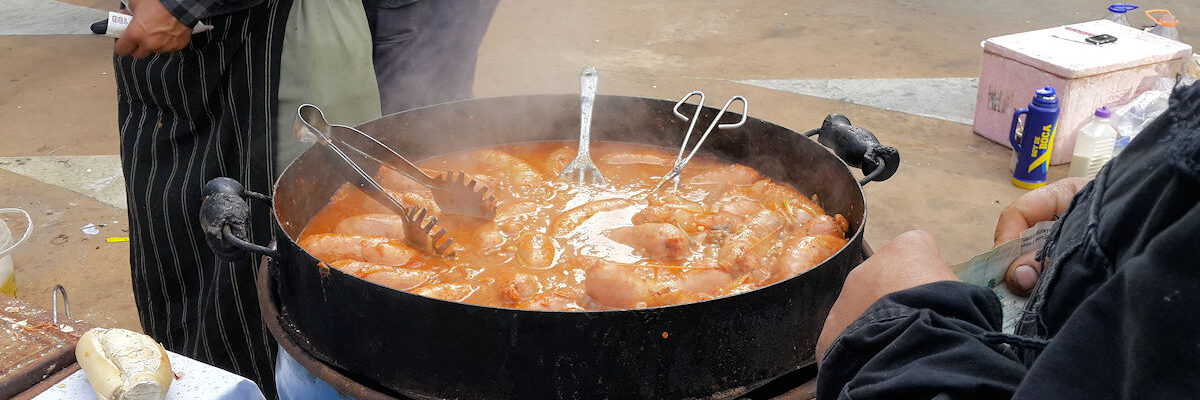
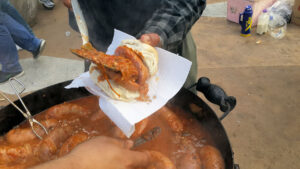
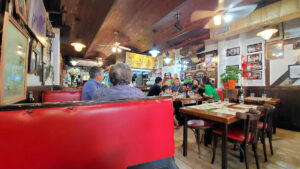
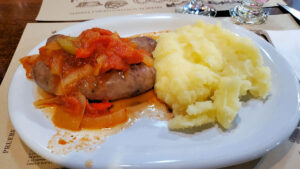
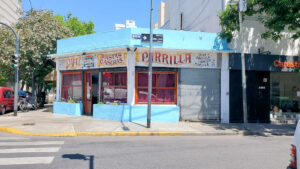
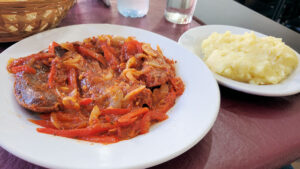
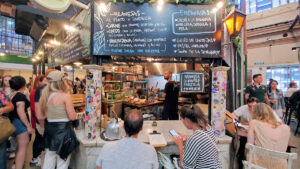
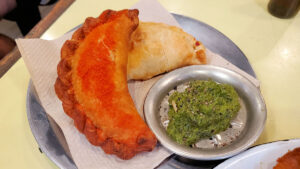
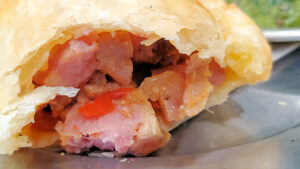

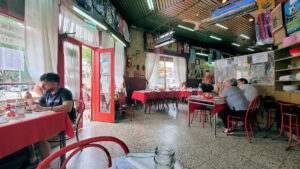
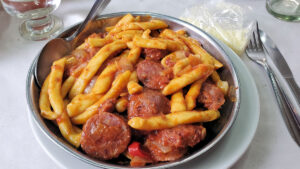
I think those collected, now-ancient recipes would be fodder for a terrific blog series. Make it happen!
I just have this feeling, from memories, and glancing at the recipes, that it would not be a positive experience… 😉
My wife linked me to this post. I’m originally from Utica, NY. Although I’m not Italian, sausage and peppers were a staple to almost any Sunday/holiday meal. My Grandpa used to make them in a cast irin pan over an ancient wood stove.
I have made sausage roll a million times, always a hit.
I miss Italian sausage so much here in Buenos Aires. I find some with marrones and then add paprika and red pepper flakes. I still make S&P in a crockpot here but miss the real thing. We’ll definitely try your suggestions, thanks!
Beth – there will be more to come, I’ve got another half dozen spots that people have recommended to try.
Yeah, it’s rare to find a butcher shop here that offers real Italian sausages, and surprising give the Italian heritage of 40%+ of the population. I’ve seen them at times at the Valenti chain, and a few other specialty shops, but they don’t always have them.
[…] the sausages for a moment, a serendipitous find at one of my neighborhood favorite bodegones, a chori a la pomarola offered up as a daily special at La Tía Zelmira, French 3015, Recoleta. This one is intense. […]